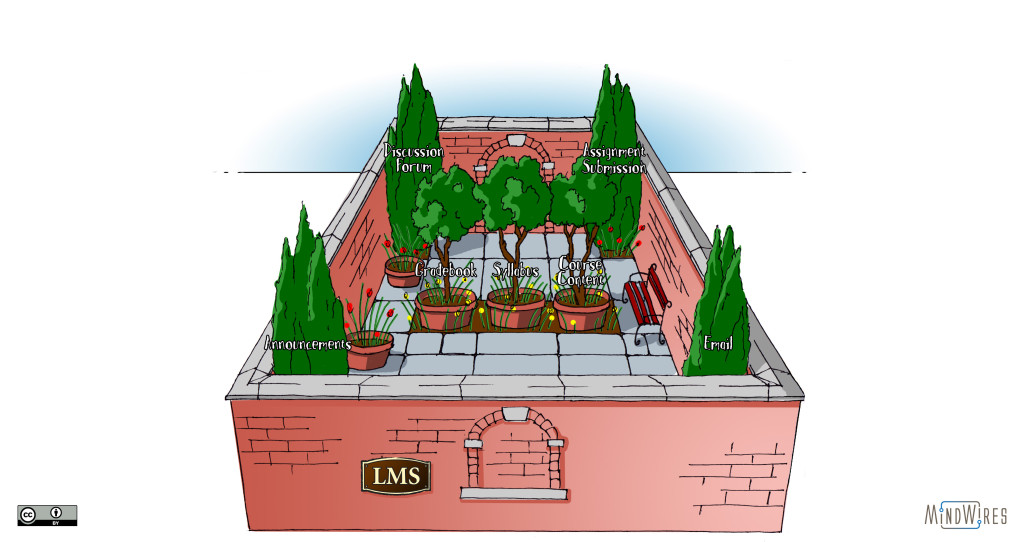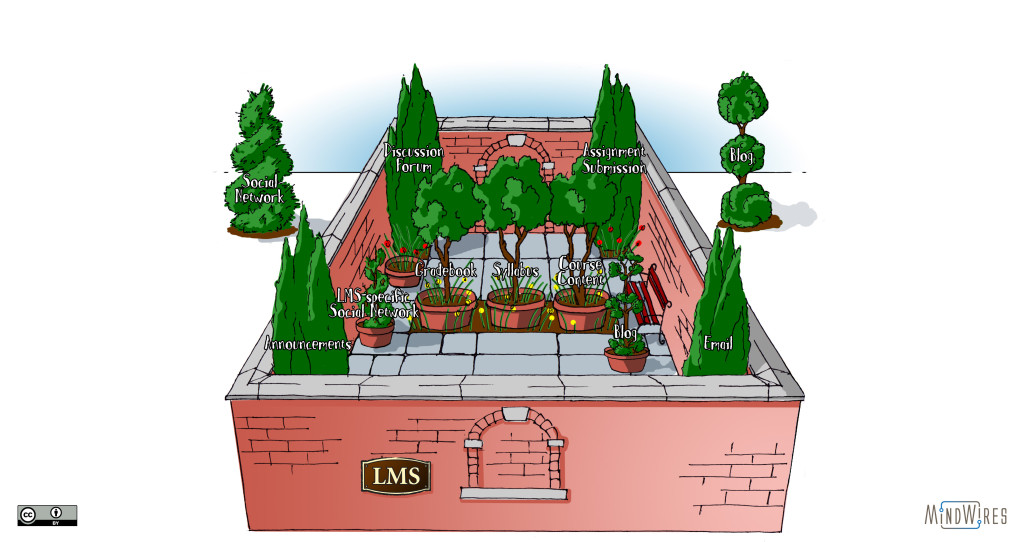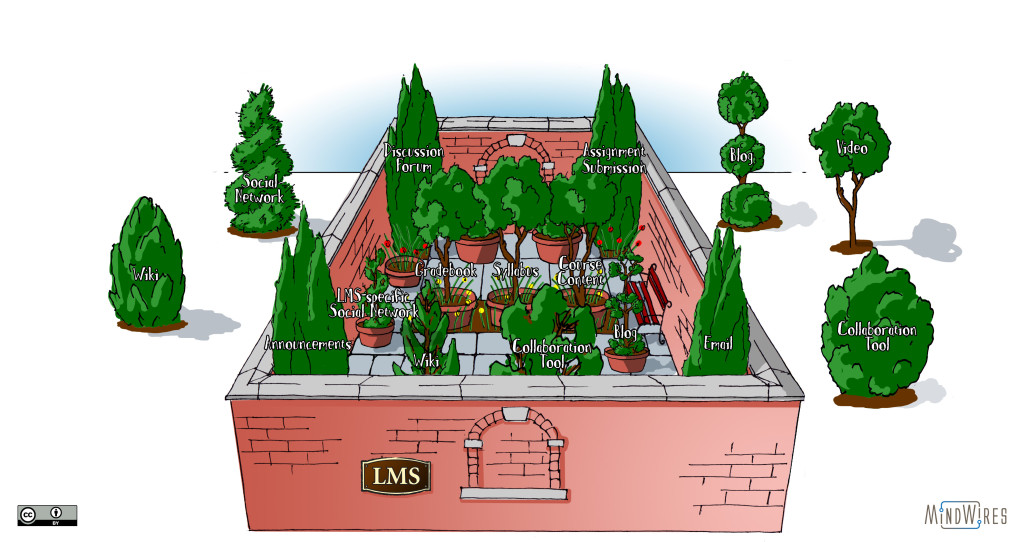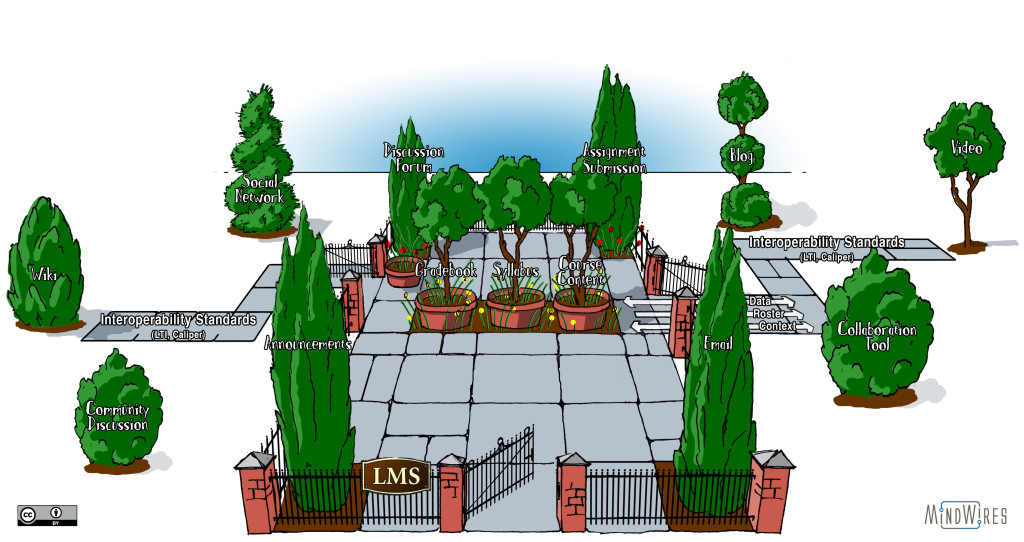In yesterday’s post I described where I (and many others) see the LMS market heading in terms of interoperability.
At the same time, the LMS does a very poor job at providing a lot of the learning technologies desired by faculty and students. There is no way that a monolithic LMS can keep up with the market – it cannot match functionality of open internet tools especially without adding feature bloat.
I would add that part of the cause of the “false binary position” that D’Arcy points out is that much of the public commentary focuses on where the LMS has been rather than where it is going. There is a significant movement based on interoperability that is leading, perhaps painfully and slowly, to a world where the LMS can coexist with open educational tools, with even end users (faculty and students) eventually having the ability to select their tools that can share rosters and data with the institutional LMS.
Coexistence and interoperability, however, should not imply merely having links from the LMS to external tools as is too often the case.
The Walled Garden
The LMS (which George Station rightly points out was really called the Course Management System in the early years) started out as a walled garden with basic functionality of syllabus sharing, announcements, gradebook, email, and a few other tools.
Over time, as both Jared Stein points out in his blog post:
Flash forward to 2005(ish), when “Web 2.0” was on many educators’ minds as a new wave of services that made it easier for anyone to express themselves to anyone who was interested in participating. New web services and social media made the legacy LMS look like what it was: A slow-moving cruise ship that locked passengers in their cabins. It didn’t care about user experience. It didn’t care about integrating with social media. It didn’t care about encouraging novel practices or experimentation. But those were really just symptoms; the sickness was that the LMS vendors didn’t care about what was happening in our culture and in our communities as connectivity and multimedia exploded through the open web.
The LMS vendors did not just ignore these new services, however, but they tried to eat their cake and have it, too, by creating poor imitations of the external tools and stuffing them inside the LMS.
As Web 2.0 tools proliferated, this approach of maintaining the walled garden was one of the primary causes of feature bloat and poorly-designed learning tools within the LMS.
False Binary – A Choice
This situation – a walled garden LMS with feature bloat and inelegant tools while multiplying external tools become available – represents the bad side of the ed tech market as it has existed. Despite the weakness of this design approach, the vendors themselves were not the only ones at fault. As Mike Caulfield points out in his description of the “elegant and extensible Prometheus:
A number of years later I asked a person I knew who worked at Prometheus why Prometheus failed. Did Blackboard crush them?
His answer was interesting. No, it wasn’t Blackboard at all. It was the educational institutions. With the slow, resource-intensive and state-mandated RFP processes, the interminable faculty commitees, and the way that even after the deal was signed the institution would delay payment and implementation as long as possible (or suddenly throw it into an unanticipated ‘final review’) it was just not possible to grow a stable business. The process institutions followed was supposed to ensure equitable access to contracts, but what it did was made it impossible for any company not sitting on a pile of cash to stay in business. (I’m extrapolating a bit here, but not much).
I would add that the RFP process also encourages a feature checklist mentality, elevating the importance of being able to say “we have that feature” and minimizing the ability to say “this design doesn’t suck”.
Many institutions have reacted slowly to the proliferation of tools and officially support only the enterprise LMS – often due to FERPA / student privacy concerns but also due to perceived inability of central units to provide support to faculty and students on multiple tools.
But this is a choice, even in the current market with limited interoperability. There are other institutions that support not only the official enterprise LMS but also multiple learning tools. While institutions have a responsibility to provide baseline LMS services for faculty, there is a strong argument that they also have a responsibility to support the innovators and early adopters that want to explore with different learning tools, whether or not they integrate with the LMS within a course.
Moving Beyond the Wall
But can the market progress such that the enterprise LMS can coexist with open tools even at the course level? The answer in my mind is yes, and the work to move in this direction has been in progress for years. Thanks to LTI specification, and in the future the Caliper interoperability framework, the vision that George Kroner describes is getting closer and closer.
But the LMSs today won’t be the LMSs of tomorrow. Rather than being a “dumping ground” for content, maybe one possible future for LMSs is as Learning Management Scaffolding – metaphorically supporting learning no matter its shape or form – with content being viewed and activities taking place inside and outside of the LMS. Maybe content will be seamlessly navigable around the LMS and the web – and perhaps in other types of systems like LCMSs – Learning Content Management Systems. Maybe learning tools of all types and sizes – but external to the LMS – will support every long-tail instructional desire imaginable while assessment results feed back into the LMS gradebook. Maybe the LMS will be the storage mechanism for leaning analytics as well, but it is more likely that it will become only one source of data feeding into another system better-suited for the task. But try as I might I fail to imagine a future in which some centrally-managed, instructor-accessible system stores rosters and grades, enforces privacy and security policies, and provides some form of starting-off point for students.
In this developing future market, coexistence of LMS and Open will include not just links or grudging institutional support, but it will also include information sharing of rosters, data, and context. Open tools that will start with the class roster in place, data of user activity shared between apps, and the ability to external apps to be run in the context of the course design and recent class activities.
There will be painful implementations – caused both by LMS vendors and by institutions – that will prevent a smooth transition to this breakdown of the walled garden, but it will become increasingly difficult for LMS solutions to survive over time if they don’t adapt. There will also be market niches (e.g. specific online programs) that will retain the walled garden LMS approach, but in general the markets should change.
I personally see the realistic future as having more of a choice of tools rather than a minimal LMS. LMS vendors will continue to have reasons to develop (or acquire) their own internal tools, and there will even be cases where the tight integration and focused development will lead to better tools in the LMS than outside. The key change will be the ability for integration decisions – which tools to use in specific classes or in specific institutions – to be made closer to the faculty and student end users. From LMS vendor to central IT to academic program to even individual faculty – moving closer to those who know the specific needs of the class. Central IT and the institution will remain important in setting policies and permissions to protect student privacy and provide guidance to faculty and course designers who are more conservative in their ed tech usage. But either way (minimal LMS or swappable tool LMS), I think the long-term trend is moving in this direction of LMS and Open tool coexistence.
Update 9/19: Updated graphics to add LMS label, CC license and logo to facilitate sharing outside of blog.




Would love to see what Pearson is doing regarding LMS these days.
The RFP-based procurement process also tends to sideline valid consideration of fully open source solutions, since there is no single vendor able to use the revenue from large proprietary licensing fees to underwrite the major expense of responding.
I don’t know what is more consistently professed year after year after year… “LMS interoperability is right around the corner” or “this is the year of the Linux Desktop.”
I’ve been guilty myself of proclaiming both (http://bit.ly/1qg2Udo & http://bit.ly/1ASea60): both noble causes and the right direction to move, but to date, over stated and overestimated.
Patrick – when LMS interoperability does come about in a meaningful way, the LMOS work at SUNY will be in the museum exhibit :} Three big differences between 2005 and 2014 to consider:
– massive increase in ed tech funding to allow experimentation and availability of apps to use in classroom; and
– IMS specs / frameworks and their general acceptance; and finally
– lack of near-monopoly in market.
Yes, I’m at risk of overestimation, but these differences change the prospects of the “noble cause” IMO.
I’d echo Patrick’s sentiments. Or to quote The Great Gatsby:
“So we beat on, boats against the current, borne back ceaselessly into the past.”
Over the years we’ve seen countless jeremiads against the LMS from Jim Groom’s cyberpunk edupunk protestations, to factions within the Sakai community proclaiming (Nietzschian like) that “the LMS is dead.” (http://tinyurl.com/me4uzdl) And yet it’s still here, refined and polished a bit around the edges, but still in its core function essentially unchanged. So much for disruption and revolution. Maybe the past has more to offer than we think — even if our hopes and dreams continue to be wrapped up in the green light of an elusive edtech future.
Luke – I prefer The Wire’s take on Gatsby:
https://www.youtube.com/watch?v=8DOy4hCih7w
I do think the ed tech past has more to offer than we think – for one, just based on all the faculty usage / student usage for the majority types not looking to be on the leading wave of ed tech.
It is pretty amazing. Like weeds – those who are “anti-LMS” just pop up from time to time. They never have any kind of better alternative other than “use Twitter to teach”. Your article does a great job of describing the evolution from closed system to expandible system (love the pictures). While there is still much work to do, the vision you propose will rule the day in the LMS space. If folks point to LMS X or LMS Y as not signing up for this strategy – it simply does not matter. Any LMS vendor that insists that the walled garden is the right approach will wilt in the next five years and effectively lose all market share. There are enough participants with a strategy of “redefine the LMS through standards and expandibility” that these will be the products that will dominate the market in the next five years. Unless the “old guard” LMS vendors get with the program – they will be pushed right out of the marketplace. Teachers and learners will win one way or another. And the Anti-LMS Harpys will be squalking about something else and not lift a finger to improve or change the marketplace.
Jarl Jonas, George Kroner ans I spent some time trying to address this problem within the Blackboard context on the CourseSites project. We created public pages for courses and instructors with a more permanent URL, a social media sharing feature and some more public blogging features. The public pages included Metadata to make them crawlable by Google. instructors could also publish the course to a common cartridre format to share all course materials. We also tried to make is easier for external participants to joim courses with account integration with Facebook, Google, etc. We also configured the LMS environmemt defaults to be more open and permissive for non-course members.
Ultimately it seemed to me that a decade plus of LMS adoption on campus created a fairly rigid view in the minds of instructors. The view that the LMS is a walled garden is strongly entrenched and those who want something else have move on to more open tools and practices.
The LMS became an entity of the school administration, subordinate to IT and IT practices. FERPA compliance, records management, security and integration with the back office dominated the conversation. Early features that allowed a more open, less walled garden configuration for courses were turned off at the institution level. No one was writing best practice guides to showcase how to connect the LMS to WordPress or Tumblr or open wikis. instead blogs and wikis inside the course just became content tools to support the walled garden. Courses were recycled semester after semester instead of being living repositories where past student discussions could be connected to the next group to come through.
This history, mindset and feature set have created a “LMS Culture” To move the people outside the walled garden will require more than new features. It will require shifting the culture to embrace the change we seek. I think it will have to happen in parallel to the ongoing upending of higher education. I think this change will create opportunities for new EdTech companies.
John – that’s interesting, as your view seems to be the flip side to Jim Groom’s coin: https://plus.google.com/112708684982385027249/posts/RtBSQenDvLp
Jim:
One simple question: where are all the compelling examples of innovative (hell I’d settle for remotely interesting) uses of the LMS for teaching and learning? That was the point I made, and immediately people came out of the woodwork defending the fact that they work with the institutional LMS. Where is the beef? Great stuff happening in the tool? Great, show me. Where are those examples to finally suggests it’s not the tool but how we use it? It’s an empty argument to suggest we are using the LMS wrong, because it is wrong for teaching and learning. Does it need to be a portal for all the open web tools? No, we can actually have use the web intelligently do that if we break free of our heroine-like addiction to the LMS, and start parceling out those few pieces that are even relevant..
It seems the two of you disagree on whether schools are using the LMS wrong (Jim says no, you say yes by configuration and faculty preconceptions), but you both refer to either a “heroine-like addiction” or an “LMS Culture”. Just interesting to note, given the different perspectives.
Personally I agree with you that institutional IT / admin control and faculty preconceptions are a big part of current LMS usage patterns. However, I think the tide is shifting over time and that institutional / faculty desires & demands are changing, albeit slowly.
Chuck – I think you and I agree on the general topic, but it will be interesting to watch your more-precise prediction that “Any LMS vendor that insists that the walled garden is the right approach will wilt in the next five years and effectively lose all market share”. I see this as accurate for general-purpose LMS, but there will be niche approaches such as 2U’s internal usage that can work with a walled garden (and to be fair, I am not sure if that is their long-term plans).